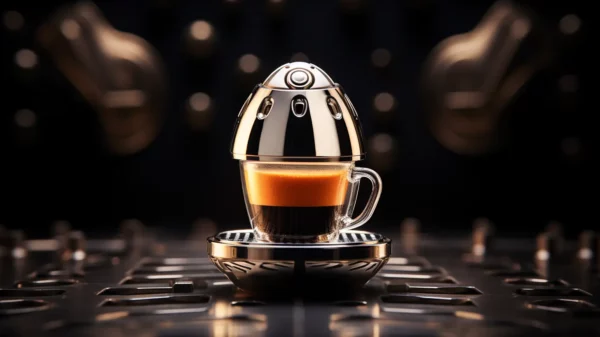When it comes to coffee, there are countless varieties and flavors to choose from. One popular choice among coffee lovers is the cappuccino, known for its rich and creamy texture. But have you ever wondered if a cappuccino is sweet? In this blog post, we will delve into the world of cappuccinos and explore the factors that can influence their sweetness. Whether you prefer a hint of sweetness or a more robust flavor, understanding the components of a cappuccino and how they contribute to its taste can help you create the perfect cup. So, let’s dive in and uncover the answer to the question: Is a cappuccino sweet?
Understanding the Basics: What is a Cappuccino
A cappuccino is a classic and beloved coffee beverage that originated in Italy. It is made by combining equal parts of espresso, steamed milk, and foamed milk, creating a harmonious blend of flavors and textures. The name “cappuccino” is derived from the resemblance of its color to the brown hooded robes worn by Capuchin monks.
At its core, a cappuccino is a coffee-based drink that offers a balanced combination of bitterness from the espresso, creaminess from the steamed milk, and a light foam layer on top. This combination creates a unique and enjoyable drinking experience.
Cappuccinos are typically served in ceramic cups, allowing the heat to be retained and ensuring that the drink stays warm for a longer period. The traditional serving size for a cappuccino is around 6 ounces, although variations in size can be found in different regions.
Now that we have a basic understanding of what a cappuccino is, let’s explore the key ingredients that contribute to its taste and texture in the next section.
The Ingredients of a Traditional Cappuccino
A traditional cappuccino is a delightful blend of three key ingredients: espresso, steamed milk, and foamed milk. Each component plays a crucial role in creating the distinct flavors and textures that make a cappuccino so beloved.
The Role of Espresso
Espresso is the foundation of any cappuccino. It is a concentrated form of coffee made by forcing hot water through finely ground coffee beans under high pressure. This process extracts the rich flavors and aromatic oils from the beans, resulting in a strong and robust coffee base. The espresso provides the characteristic bitterness and strength that balances the sweetness and creaminess of the other ingredients.
The Impact of Steamed Milk
Steamed milk is another vital component of a cappuccino. It is created by heating milk and introducing steam to create a velvety and creamy texture. The steaming process also adds a subtle sweetness to the milk. When incorporated into the cappuccino, the steamed milk helps to mellow the strong espresso flavor and adds a smooth and luxurious mouthfeel.
The Effect of Foamed Milk
Foamed milk, also known as milk foam or froth, is created by introducing air into the milk during the steaming process. This results in a light and airy layer of foam on top of the cappuccino. The foam adds a delicate texture and enhances the overall visual appeal of the drink. It also contributes to the creaminess and richness of the cappuccino experience.
These three ingredients, espresso, steamed milk, and foamed milk, come together to create the perfect balance of flavors and textures that define a traditional cappuccino. In the next sections, we will explore how these ingredients can impact the sweetness of the cappuccino and what factors can influence its overall taste.
Factors That Can Make a Cappuccino Sweet
The sweetness of a cappuccino can be influenced by several factors, including the coffee beans used, the sweetness of the milk, and the addition of sugar or sweeteners. Let’s delve into each of these factors in more detail.
The Influence of the Coffee Beans
The type and roast level of the coffee beans used in the espresso can greatly impact the sweetness of a cappuccino. Different coffee beans have varying levels of natural sweetness, acidity, and bitterness. For example, beans with fruity or chocolatey flavor notes tend to contribute to a sweeter taste profile. Similarly, a lighter roast can enhance the natural sweetness of the beans compared to a darker roast that may introduce more bitterness.
Impact of Milk and Its Sweetness
The sweetness of the milk used in a cappuccino can also affect its overall taste. Milk naturally contains lactose, a type of sugar that adds a subtle sweetness. Different types of milk, such as whole milk, skim milk, or alternative milk options like almond or oat milk, can have varying levels of sweetness. Additionally, the freshness and quality of the milk can play a role in the sweetness and creaminess of the cappuccino.
Addition of Sugar or Sweeteners
Many coffee enthusiasts prefer to customize the sweetness of their cappuccino by adding sugar or sweeteners. This allows for personal preference and control over the level of sweetness. Common options include granulated sugar, brown sugar, honey, agave syrup, or artificial sweeteners. The amount and type of sweetener added can significantly impact the overall sweetness of the cappuccino.
Understanding these factors can help you make informed decisions when it comes to selecting coffee beans, milk, and sweeteners to create a cappuccino with your desired level of sweetness. In the next section, we will discuss how to adjust the sweetness of your cappuccino to suit your taste preferences.
How to Adjust the Sweetness of Your Cappuccino
Adjusting the sweetness of your cappuccino allows you to personalize your drink according to your taste preferences. Here are some techniques you can use to achieve your desired level of sweetness:
Choosing the Right Coffee Beans
Start by selecting coffee beans with flavor profiles that align with your preference for sweetness. Experiment with different beans, such as those with fruity or chocolatey notes, to find the perfect balance of flavors. Additionally, consider the roast level of the beans. Lighter roasts often have brighter and sweeter flavors, while darker roasts may introduce more bitterness.
Adjusting the Amount of Milk
The amount of milk used in your cappuccino can directly impact its sweetness. If you prefer a sweeter cappuccino, consider adding more steamed milk to the mix. The additional milk will dilute the strength of the espresso and bring out the natural sweetness of the drink. Conversely, if you prefer a less sweet cappuccino, decrease the amount of steamed milk and opt for a stronger espresso flavor.
Adding Sweeteners
Adding sweeteners is a common method to adjust the sweetness of a cappuccino. You can use various options such as granulated sugar, brown sugar, honey, agave syrup, or artificial sweeteners. Start by adding a small amount of sweetener and gradually increase until you achieve the desired level of sweetness. Remember to stir well to ensure the sweetener is evenly distributed throughout the drink.
Experimenting with Flavored Syrups
Another way to enhance the sweetness and add unique flavors to your cappuccino is by using flavored syrups. These syrups come in a wide range of flavors such as vanilla, caramel, hazelnut, or chocolate. Simply add a pump or two of your chosen syrup to your cappuccino and stir to incorporate the flavors. Keep in mind that some syrups may already contain added sweetness, so adjust the amount accordingly.
By adjusting the coffee beans, the amount of milk, and incorporating sweeteners or flavored syrups, you can create a cappuccino with just the right amount of sweetness. Don’t be afraid to experiment and find the perfect balance that suits your taste buds. In the next section, we will address some common misconceptions about the sweetness of cappuccinos.
Common Misconceptions About the Sweetness of Cappuccino
There are several common misconceptions surrounding the sweetness of cappuccinos. Let’s address some of these misconceptions to gain a clearer understanding:
Misconception 1: Cappuccinos are inherently sweet
Contrary to popular belief, cappuccinos are not inherently sweet. The natural flavors of a cappuccino come from the combination of espresso, steamed milk, and foamed milk. While the steamed milk adds a subtle sweetness, the overall taste profile is balanced and can vary depending on the factors mentioned earlier, such as coffee bean selection and the amount of sweetener added.
Misconception 2: Sweeteners are necessary for a good cappuccino
While adding sweeteners is a personal preference, it is not necessary for a good cappuccino. The quality of the coffee beans, the skill in brewing the espresso, and the steaming and foaming of the milk all contribute to the taste and enjoyment of a cappuccino. Some coffee enthusiasts prefer to appreciate the natural flavors of the beverage without any additional sweeteners.
Misconception 3: Cappuccinos always have a sugary foam layer
While a traditional cappuccino is known for its foamed milk layer on top, this layer does not necessarily mean it is sweet. The foam is created by introducing air into the milk during the steaming process, resulting in a light and airy texture. The foam itself does not contain added sweetness unless a sweetener or flavored syrup is used.
Misconception 4: Sweetness is the only factor that determines a good cappuccino
The sweetness of a cappuccino is just one element of its overall taste. A well-balanced cappuccino should have a harmonious combination of flavors, including the bitterness of the espresso, the creaminess of the steamed milk, and the texture of the foam. It is the interplay of these elements that contributes to a satisfying cappuccino experience.
Understanding these common misconceptions can help you appreciate the complexity of cappuccinos and make informed decisions when it comes to customizing your drink. In the final section, we will conclude our exploration of whether a cappuccino is sweet and summarize the key takeaways.
Conclusion
In conclusion, the sweetness of a cappuccino can vary depending on several factors. While a cappuccino is not inherently sweet, it offers a balanced combination of flavors and textures that can be adjusted to suit individual preferences.
The key ingredients of a traditional cappuccino are espresso, steamed milk, and foamed milk. The type and roast level of the coffee beans used, the sweetness of the milk, and the addition of sugar or sweeteners all contribute to the overall sweetness of the beverage.
To adjust the sweetness of your cappuccino, you can experiment with different coffee beans, vary the amount of steamed milk, and add sweeteners or flavored syrups according to your taste. Remember that sweetness is just one aspect of a well-crafted cappuccino, and factors like the quality of the coffee beans and the skill in brewing the espresso also play important roles in creating a satisfying drink.
It is important to debunk the common misconceptions surrounding the sweetness of cappuccinos. Cappuccinos are not inherently sweet, and the addition of sweeteners is a personal preference. The foam layer on top of a cappuccino does not necessarily indicate added sweetness, and sweetness alone does not determine the quality of a cappuccino.
Ultimately, the sweetness of a cappuccino is a subjective experience that can be tailored to suit individual tastes. Whether you prefer a slightly sweet cappuccino or a more robust flavor, understanding the components and factors that influence the sweetness allows you to create a cappuccino that brings you joy with every sip.
So, the next time you indulge in a cappuccino, take a moment to appreciate the intricate balance of flavors and textures, and savor the unique experience it offers. Cheers to the delightful world of cappuccinos!










